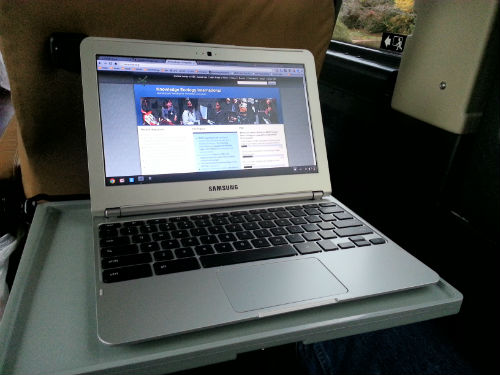 Yesterday I received a Samsung laptop computer running Google’s Chrome OS. This is the new $249 Chromebook with an SSD drive, 2 gigs of RAM, an 11.6 inch 1366 x 768 pixels screen, and the 1.7 GHz Exynos 5200 processor. The laptop weights 2.4 pounds and has a nice usable keyboard and a well implemented trackpad. There is also the option of a model with 2 years of 3G (limited) data from Verizon, for just $329. Both of the new Samsung models* are chronically sold out and hard to find (some resellers are getting $100 to $150 over the suggested retail price). While the Samsung hardware is surprisingly nice for the money, the real story is the new Google OS.
Yesterday I received a Samsung laptop computer running Google’s Chrome OS. This is the new $249 Chromebook with an SSD drive, 2 gigs of RAM, an 11.6 inch 1366 x 768 pixels screen, and the 1.7 GHz Exynos 5200 processor. The laptop weights 2.4 pounds and has a nice usable keyboard and a well implemented trackpad. There is also the option of a model with 2 years of 3G (limited) data from Verizon, for just $329. Both of the new Samsung models* are chronically sold out and hard to find (some resellers are getting $100 to $150 over the suggested retail price). While the Samsung hardware is surprisingly nice for the money, the real story is the new Google OS.
What Google has done with Chrome OS is create a serious mass market operating system for desktop computers, from Linux. It is surprising that this has taken so long to happen, and also somewhat surprising that Google has positioned the OS as something for small screen computers mostly on the cloud, when the OS could easily be implemented (and maybe it will) for a wider range of devices and uses. The immediate impact will to make it hard to justify buying the 11.6 inch Mac Air, which starts at $999. But the OS is good enough to make much larger inroads into the desktop computing market. It is more than a thin client, with enough off-line functionality make most users happy, and the early Chromebooks show that it is possible to have very tight integration between the Linux software and hardware.
I have been using several different desktop and laptop computers, mostly running the Ubuntu distribution of Linux, and also occasionally using a computer running the Apple OSX or Microsoft’s Windows. As much as I like Ubuntu, it seems unlikely to make serious inroads into the Apple or Microsoft desktop OS markets, at least for the foreseeable future. But the Chrome OS is unlike any other desktop Linux distribution. It makes the Apple OSX seem complicated, and anyone, and I mean anyone, can pick up a Chromebook and use it right away.
I like having an 11.6 to 13 inch computer for travel, and its nice to have something that is light (a real “laptop”) and fits in the space for economy seats on an airplane or in the cramped space you have at a conference, and which has a good battery life. But I would also like to see this OS implemented in a 14 or 15 inch ultrabook hardware configuration, with a bit more hefty processor and more ram and diskspace. When that happens, both Apple and Microsoft will have to deal with some big changes in their business models.
* There some other hardware options from Samsung and Acer, including a new $199 laptop from Acer and a Samsung Chromebox, which requires external monitors and keyboard.
Comments are closed.